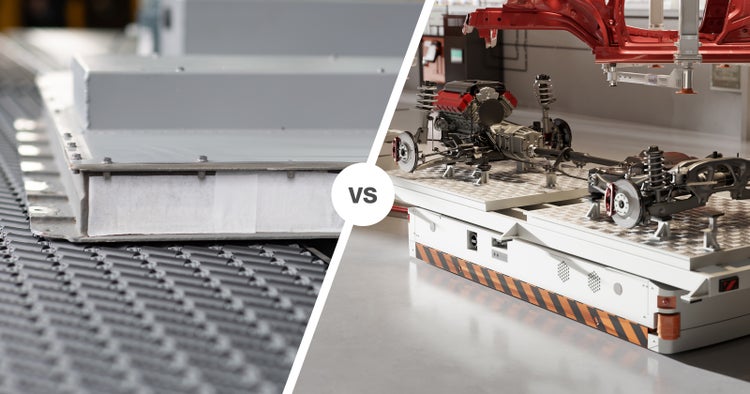Has Your EV Battery Operation Outgrown AGVs?
Keeping Your Production Scalable in a Rapidly Changing Market
- Insights
- November 13, 2023

Moving your products down the line as an electric vehicle (EV) battery manufacturer isn’t as simple as moving a box of toys.
No, your battery packs are contradictions—heavy but delicate. They need gentle, controlled handling to prevent damage, but they demand incredible strength to lift and withstand their weight. Such solutions can get expensive quickly.
To fill this need without spending a fortune, EV battery producers have typically turned to automated guided vehicles (AGVs). They get the job done for smaller operations, and they’re cost effective when considered against more robust conveyance solutions.
But how long can AGVs stay relevant in your rapidly evolving market? How do you know when you’ve outgrown them? Is there a more permanent solution—one that’s affordable for your operation’s size?
“As the electric vehicle battery market started to expand, we immediately began exploring potential applications for our technology,” says Enrico Carca, Application Engineer at Intralox. “Our innovative solutions are already well established across various industries, and we saw an opportunity to help customers achieve the same level of performance and cost benefits we’ve delivered in other sectors.”
Utilizing Intralox Activated Roller Belt (ARB) technology in EV battery production, for instance, is currently improving production efficiency for our partners by eliminating bottlenecks and enhancing scalability.
We caught up with our experts to discuss this new application, how ARB technology’s performance compares to that of AGVs, and when ARB equipment becomes the right solution for our EV partners.
Outgrowing AGVs
AGVs appeared in the automotive industry long before electric vehicles. They were flexible enough to work within many layouts, and strong enough to move large products. But while the industry has evolved, AGVs have largely stayed the same.
“They were mainly used to bring subassemblies along vehicle assembly lines,” says Joel Picard, Global Account Team Leader at Intralox. “This application has continued into the EV era.”
Though they’re now considered a less robust technology when compared to general conveyance solutions, there are still benefits to using them today. In fact, AGVs remain the solution of choice for most new production areas because they allow easy startup with no civil works modification.
“They’re well known and easy to implement,” Picard says. “They don’t require heavy infrastructure development, so they provide and will continue to provide value for low-scale production systems.”
But that’s exactly where many of our partners run into issues: Their aspirations aren’t “low scale.”
“AGVs suffer from low cycle time,” Picard elaborates. “It’s inherent to their stop-and-start way of working.”
Because of this, they’re inefficient for functions like sorting, merging, and aligning. And despite their layout flexibility, they still have limitations meeting specific needs, such as accomplishing L- or U-turns.
“Other concerns around AGVs are related to lifespan,” Picard adds. “Mostly mechanical breakdown, programming and controls issues, and software obsolescence.”
Though their lower cost and startup effort compared to more robust conveyance solutions can be attractive for low-volume operations, plants often quickly look for a solution that can offer a more uninterrupted product flow.
Scaling Production
Once AGV cycle time becomes an issue for your production, it’s time to consider general conveyance.
“All of our partners’ ARB installations were driven by throughput demand,” Carca says. “Their goals were impossible or too expensive to reach with existing technology.”
If you find yourself in that situation, conveyance solutions in general will offer faster and more reliable production than AGVs, empowering you to keep up with increasing volume. This uninterrupted product flow is the hallmark promise of our ARB technology, even in applications that require additional functions like sorting, merging, and aligning.
“ARB is a proven and reliable technology,” Carca says. “Designed as a high-throughput conveyance system, it outshines traditional AGVs by providing a seamless, user-friendly, and low-maintenance solution for the efficient transportation of goods from point A to point B.
“Our technology can guarantee high throughput—up to 80 parts per minute—with limited investment compared to AGVs,” Carca continues. “There’s no need for advanced controls to successfully integrate the equipment, and plant personnel can be easily trained to perform its maintenance.”
“Long-distance handling is another situation where ARB offers a clear advantage over AGVs,” Picard adds.
On that note, conveyor-based solutions do require more layout planning and forethought than AGVs given their size and permanence. But once accepted as part of your operation’s growth, that can be a benefit.
“With conveyors, a well-thought-out layout is mandatory,” Picard explains. “But thanks to its wide range of possible functions, ARB can actually simplify layouts. For example, it could allow for merge and reject points, which are difficult to realize with AGVs.
“This is why Intralox partners with its customers to design future-proof layouts,” Picard continues. “We have comprehensive tools like physics-based simulation that allow us to provide layout optimization services.”
We also work with our partners to figure out if active or passive technology is right for their applications. While active technology can be used for truly touchless applications, passive solutions offer the same flexibility- and maintenance-related benefits at a lower cost—lower even than the cost of AGVs.
This is why Intralox partners with its customers to design future-proof layouts.
Global Account Team Leader at Intralox
Finding the Right Fit for You
The first thing many operations do when they need to increase throughput is simply duplicate their AGV flow. The jump from that to conveyance solutions may seem like an insurmountable step.
But ARB technology doesn’t always demand an instant and complete overhaul. As with many of our solutions, it can first supplement your existing technology, creating an innovative blend of benefits without too much disruption or cost.
“ARB allows faster processes and could become complimentary to AGVs in some situations,” Picard says. “It could offer additional functions to A-B handling like sorting, merging, and aligning.”
In fact, Picard speculates that hybrid handling processes—combining AGVs and conveyors—will likely become the norm as industry throughput increases.
Intralox is always looking for improvements. We built a full-scale loop available for customer testing and internal development. Durability and accuracy tests are running at this moment to collect data for new applications.
Application Engineer at Intralox
“Some assembly steps will remain with AGVs, perhaps with two or three loops in parallel,” Picard explains. “Other steps in the process will get conveyors—conventional or ARB—to allow fast and uninterrupted product flow. But ARB is only one answer out of many that Intralox has for efficient conveying.”
Because as always, Intralox is constantly innovating—especially in fast-changing industries like EV and EV-battery production—to ensure that our partners stay ready for the future.
Move Further, Faster
ARB technology is a patented, automated conveyance solution that creates new possibilities for system or line layouts.


